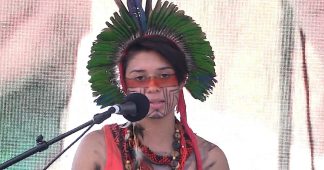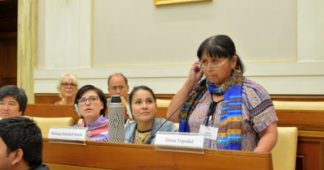March 4, 2019
“There’s really no such thing as the ‘voiceless’. There are only the deliberately silenced, or the preferably unheard.” – Arundhati Roy
“We must answer their call. Our Mother Earth, militarized, fenced-in, poisoned, a place where basic rights are systematically violated, demands that we take action. Let us build societies that are able to coexist in a dignified way, in a way that protects life. Let us come together and remain hopeful as we defend and care for the blood of the Earth and of its spirits.” – Berta Caceres, Indigenous rights and environmental activist of the Lenca people, murdered in Honduras in 2016
A few years ago when I was in Panama I was fortunate to spend some time with the indigenous Ngäbe–Buglé. They reside in the lush rainforest that blankets much of the country. Their villages are simple, but graciously laid out with the natural world around them. The people have a reverence for wildlife, using only what they need, and culture, ancestral ways and community are paramount. But as in every other place on the planet they have been under siege by the forces of capital.
Dam projects largely devised to benefit mining companies have inundated scores of villages and devastated farms and fishing. Rare species like the Tabasará rain frog are threatened with extinction due to the loss of habitat. Four years ago a dam claimed a small indigenous village on the sacred Tabasará River. The villagers narrowly escaped drowning as their homes flooded in the night. They were given no warning.
In May of last year the river was shut down for maintenance on the Barro Blanco hydroelectric dam. Tens of thousands of fish and crustaceans were left to suffocate in the mud. Many more dam projects are planned for this small country. While the Ngäbe–Buglé have protested their dispossession and the destruction to their way of life, they have been met with threats, disappearances and violence from the state and operatives from various companies who stand to benefit from the projects. But the lords of capital, the banks, hold the most power. For instance, FMO Bank of Holland and DEG Bank of Germany were responsible for the Barro Blanco dam.
In stark contrast to the Ngäbe–Buglé way of life is the wealthy new high rise section of the capital, Panama City. Here glass and steel towers scrap an unforgiving hot Central American sky. Yet there are few sidewalks in this area. The moneyed elite drive directly into their palatial condos through secured garage doors on the street. There isn’t a need nor is there a desire to walk here unless you are poor.
It is a landscape of alienation repeated around the world from Jakarta to Manilla to Mumbai where the wealthy cordon themselves off from an ever growing peasantry behind gilded gates. But about an hour and a half away from the capital is the forgotten city of Colón where most of the inhabitants are people of colour and poverty is crushing. In truth, most of the extreme wealth entering the Panama Canal is concentrated in the ruling top .01%.
And this gets to one of the most tragic outcomes of these economic and ecological assaults: displacement. Millions of indigenous people around the world have been evicted from their ancestral lands only to wind up in the hellhole slums of megacities. Here they are most often locked in poverty, forced to abandon their culture and language for conformity, and forgotten by society. To be sure, this is the world that global capitalism envisions for us all.
But whether it is the Ngäbe–Buglé in Panama, or the Bonda of India, or the Wet’suwet’en in Canada, or the Papuan in New Guinea, or the Kariri-Xoko in Brazil, or the Aboriginal in Australia, or the Ogoni in Nigeria, or the Lakota in the US the threat of annihilation is both real and imminent. Thanks to a system of global capital they are up against powerful forces that seek to strip the earth of every last resource for the profit of a few. And they will eliminate anyone who stands in their way. The NGO Global Witness reported that over 200 indigenous rights activists have been murdered around the world last year. A record. The activist Berta Caceres was a victim of this global crime. And today there is no sign of this carnage slowing down.
The assaults on indigenous people around the world bear one thing in common. These are the people on the front lines of a war for what remains. A war of resources that amount to enormous profits for the very few. Of course they have always been on that front line since the early days of colonialism. Days where outright genocide was common. But through the lens of catastrophic climate change and biospheric collapse the current economic order must be seen as the death cult that it is. Incapable of introspection or self-restraint. Drunk on their hubris and narcissism. Ominicidal in their pursuit of coin. And it is the indigenous who are closest to the living earth who stand most in the way of their plunder. They are rendered non-persons in corporate media and displaced or eliminated so that the flow of capital continues uninterrupted. And with capitalism itself on its last legs, that death cult is becoming ever more desperate, duplicitous, vicious and bold.
I remember when I was in Panama walking through a Ngäbe village on a balmy afternoon. Insects hummed around me. Tropical birds pierced the canopy of trees with shrieks. The humid air dampened my clothes. I could hear the sounds of children laughing as they came home from school. Old women hung out colourful clothes to dry and they immediately reminded me of Tibetan prayer flags. A young artist was sitting in his cabin with the door open carving a beautiful piece of fallen wood. He looked at me and smiled. “Welcome, and come in,” he said. I wonder sometimes what has become of him and that village. But I will admit I am afraid to find out.
Published at https://www.counterpunch.org/2019/03/04/the-global-assault-on-indigenous-peoples/











